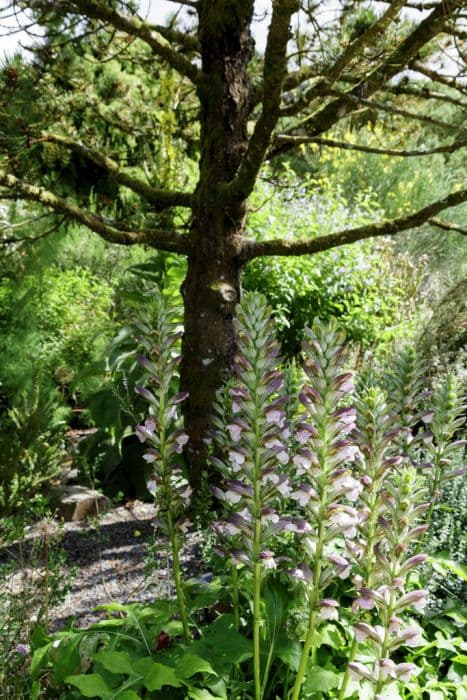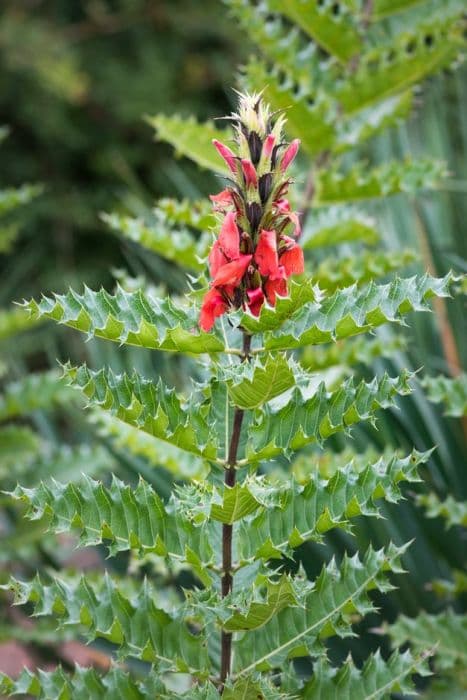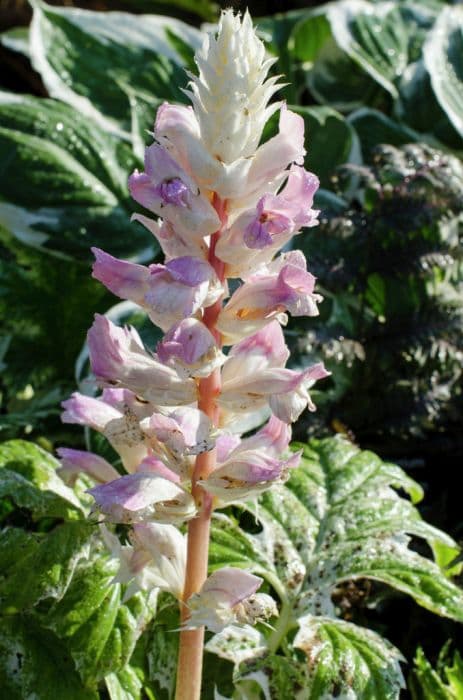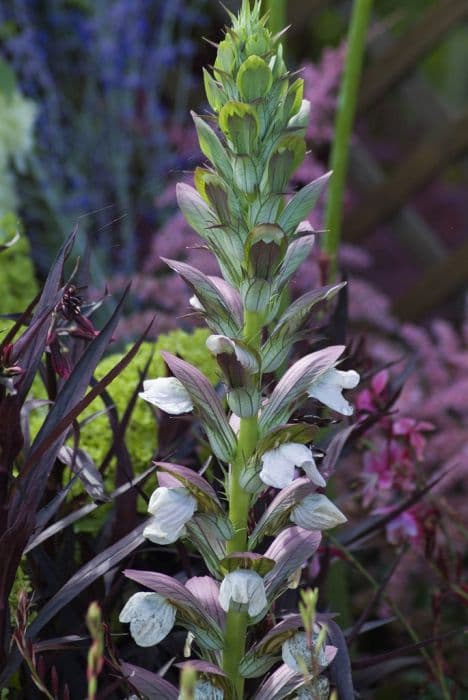Ribbon Bush Hypoestes aristata

ABOUT
Hypoestes aristata, commonly known as the ribbon bush, is a vibrant, evergreen perennial known for its decorative features. The plant typically bears dark green leaves speckled with contrasting hues of pink, lavender, or white, creating a polka-dot effect that is very attractive and adds a splash of color to any setting. The foliage has a lush, bushy appearance and consists of pointed, lance-shaped leaves that cluster densely along the stems, contributing to the plant's full, textured look. During the blooming period, the ribbon bush produces an abundance of small, tubular flowers that have a notable, fluffy appearance. These flowers usually come in shades of mauve or purple and are arranged in spikes that shoot up and stand out nicely against the vivid foliage. Overall, the ribbon bush is cherished for its highly ornamental leaves and showy floral displays that can add a whimsical touch to gardens, making it a popular choice among gardeners looking to inject a bit of playful color and texture into their landscapes.
About this plant
 Names
NamesFamily
Acanthaceae
Synonyms
Ribbon Bush, Flamingo Plant
Common names
Hypoestes verticillaris, Eranthemum verticillare, Ecbolium verticillare, Hypoestes pubescens, Peristrophe aristata
 Toxicity
ToxicityTo humans
The Hypoestes aristata, commonly known as the Ribbon Bush, is not widely known to be toxic to humans. However, like with many plants, sensitivity to it can vary from person to person. Ingesting any part of the plant is likely not harmful, but it’s always best to avoid eating plants not confirmed as safe for consumption. There's no well-documented evidence of the Ribbon Bush causing poisoning symptoms in humans.
To pets
The Ribbon Bush (Hypoestes aristata) is not widely known to be toxic to pets either. There is a lack of significant evidence suggesting that pets would experience poisoning symptoms upon ingestion. However, it is always prudent to prevent pets from eating plants not meant for consumption, as individual reactions can vary, and there could be a possibility of gastrointestinal upset or an allergic reaction in sensitive pets.
 Characteristics
CharacteristicsLife cycle
Perennials
Foliage type
Evergreen
Color of leaves
Variegated
Flower color
Pink
Height
2 feet (0.61 meters)
Spread
2 feet (0.61 meters)
Plant type
Shrub
Hardiness zones
10
Native area
South Africa
Benefits
 General Benefits
General Benefits- Aesthetic Appeal: Hypoestes aristata, commonly known as Ribbon Bush, adds a burst of color to gardens with its attractive pink or purple flowers.
- Habitat for Wildlife: It provides nectar for pollinators like bees and butterflies, supporting biodiversity.
- Erosion Control: The plant can help in stabilizing soil and preventing erosion with its root system.
- Drought Tolerance: Ribbon Bush is relatively drought-tolerant once established, making it suitable for dry climate gardens.
- Low Maintenance: It requires minimal care beyond the basic needs of water and occasional pruning.
- Fast Growth: Ribbon Bush grows quickly, providing a quick way to fill spaces in the garden.
- Shade Tolerance: This plant can tolerate partial shade, making it versatile for different garden spots.
 Medical Properties
Medical Properties- Anti-inflammatory: Hypoestes aristata may possess anti-inflammatory properties, which could potentially help in reducing inflammation.
- Antimicrobial: The plant is traditionally used for its potential antimicrobial effects against certain bacteria and fungi.
- Wound healing: There are traditional uses that suggest the plant has wound healing benefits, possibly due to antimicrobial and anti-inflammatory properties.
- Respiratory health: In traditional medicine, the plant has been used to treat respiratory conditions due to its possible expectorant properties.
- Pain relief: The plant may have analgesic properties used in traditional medicine to alleviate pain.
 Air-purifying Qualities
Air-purifying QualitiesThis plant is not specifically known for air purifying qualities.
 Other Uses
Other Uses- Hypoestes aristata, commonly known as ribbon bush, can be used in butterfly gardens as it attracts pollinators with its vibrant flowers.
- The plant can be used to add color contrast in floral arrangements because of its spotted foliage and purple flowers.
- Ribbon bush can be planted in terrariums, adding height and texture due to its patterned leaves and bushy growth habit.
- In educational settings, Hypoestes aristata can be an example to teach about plant propagation through cuttings as it roots easily in water or soil.
- It is beneficial in mixed container plantings for balcony gardens to provide a backdrop for lower growing flowering plants.
- Ribbon bush can be used in thematic gardens, such as 'Alice in Wonderland,' because of its unique and whimsical spotted foliage.
- It can also serve as a living Easter decoration when paired with pastel-colored flowers and Easter-themed ornaments.
- The plant can be crafted into a natural dye for textiles, potentially yielding a range of pink to purple hues.
- Artists may use the crushed leaves of Hypoestes aristata to create botanical prints or natural pigments for artwork.
- Ribbon bush can be part of sensory gardens for the visually impaired as its foliage provides interesting tactile feedback.
Interesting Facts
 Feng Shui
Feng ShuiThe Polka Dot Plant is not used in Feng Shui practice.
 Zodiac Sign Compitability
Zodiac Sign CompitabilityThe Polka Dot Plant is not used in astrology practice.
 Plant Symbolism
Plant Symbolism- Diversity: Hypoestes aristata, commonly known as Polka Dot Plant, often symbolizes diversity due to the variety of colors and patterns found on its leaves, representing the beauty of different characteristics and uniqueness.
- Protection: The Polka Dot Plant's appearance with spots has been associated with the idea of warding off negative energies, thus symbolizing protection.
- Playfulness: With its spotted leaves and joyful demeanor, the Polka Dot Plant represents playfulness and cheer, adding a light-hearted touch to its surroundings.
- Growth: As a houseplant that grows well under proper care, the Polka Dot Plant can symbolize personal growth and the importance of nurturing one’s environment.
 Water
WaterThe Polka Dot Plant (Hypoestes aristata) prefers consistent moisture. Water the plant when the top inch of soil feels dry, which generally means watering approximately once a week. Use lukewarm water and pour it evenly around the base of the plant, avoiding the leaves, until water runs out of the drainage holes. Depending on the size of the pot, this might typically require around 16 to 32 ounces of water per watering. During the active growth period in spring and summer, the plant may need more frequent watering, while in the cooler months, you should reduce the frequency.
 Light
LightPolka Dot Plants thrive in bright, indirect sunlight. Place them near a window that receives filtered sunlight or in a spot that is bright without direct exposure to harsh sun rays, which can scorch their leaves. East-facing or north-facing windows are often ideal locations for these plants to receive the appropriate amount of light.
 Temperature
TemperatureThe Polka Dot Plant prefers a warm and stable environment with temperatures ranging from 60°F to 80°F. They should not be exposed to temperatures below 50°F as cold drafts can severely harm them. The ideal growing conditions are at room temperature, around 70°F to 75°F.
 Pruning
PruningPrune the Polka Dot Plant to encourage bushier growth and to maintain its shape. Trim the tips of the stems and any leggy growth throughout the growing season. The best time to prune is in the spring or early summer, and periodic pruning every couple of months can help keep the plant looking full.
 Cleaning
CleaningAs needed
 Soil
SoilPolka Dot Plant thrives in a well-draining, fertile potting mix with peat or coco coir as the base. A mixture of two parts peat or coco coir to one part perlite is ideal. Ensure the soil mix holds moisture without becoming soggy, and aim for a soil pH between 6.0 to 6.5.
 Repotting
RepottingPolka Dot Plants should be repotted roughly every 1-2 years or when they outgrow their current pot. The best time to repot is in the spring or early summer to allow the plant to adjust to its new pot during the growing season.
 Humidity & Misting
Humidity & MistingPolka Dot Plant prefers high humidity levels, generally between 50-60%. In dry environments, supplement humidity with a humidifier or by placing the pot on a tray of wet pebbles to create a more humid microclimate around the plant.
 Suitable locations
Suitable locationsIndoor
Place Polka Dot Plant in bright, indirect light and high humidity indoors.
Outdoor
Grow Polka Dot Plant in partial shade with protection from strong sun outdoor.
Hardiness zone
10-11 USDA
 Life cycle
Life cycleHypoestes aristata, commonly known as the Ribbon Bush, begins its life cycle as a seed, which germinates in moist, well-drained soil under partial light. The seedling develops a root system and foliage as it grows into a young plant, thriving in warm conditions. During its vegetative stage, the Ribbon Bush produces distinctive green leaves with splashes of pink, white, or red, depending on the variety. When mature, it blooms with spikes of small, tubular purple or pink flowers, typically in the fall or winter, attracting pollinators. After pollination, the flowers produce seed pods that eventually dry and release seeds, completing the reproductive cycle. The Ribbon Bush can also be propagated vegetatively through cuttings, allowing for the continuation of the life cycle without the need for seeds.
 Propogation
PropogationPropogation time
Spring-Early Summer
The most popular method of propagating Hypoestes aristata, commonly known as Flamingo Flower or Polka Dot Plant, is by stem cuttings. To propagate by cuttings, a healthy stem tip about 4 to 6 inches (10 to 15 centimeters) long is cut from the plant during the warm growing season, generally in spring or summer. The cut end is then dipped in rooting hormone to enhance root development and planted in a moist potting mix. The pot should be placed in a warm, brightly lit area but out of direct sunlight to avoid scorching the delicate new growth. To retain humidity, which benefits root growth, the pot can be covered with a plastic bag, ensuring it does not touch the leaves. Roots typically begin to form within a few weeks, after which the new Flamingo Flower plant can be gradually acclimated to less humid conditions and continue its growth.








